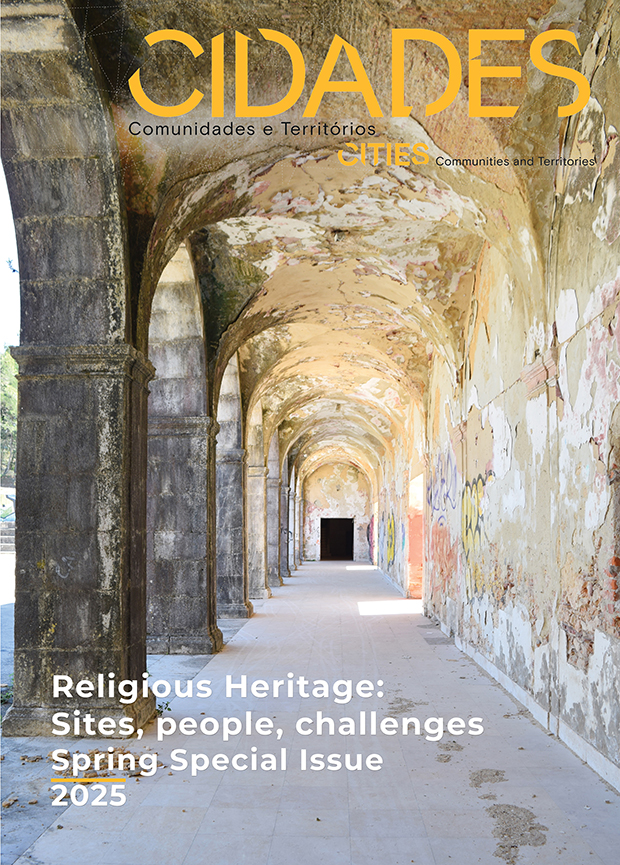Sul Abobadado Sagrado
Propondo análise de cluster de abóbadas e itinerários culturais em edifícios de património religioso baseado em GIS
Palavras-chave:
Religious architecture, Vaults and domes, Southern Portugal, GIS itineraries, Vaulted South PlatformResumo
No sul de Portugal, as abóbadas de tijolo são um sistema construído tradicional particular para coberturas, pisos e terraços, usando materiais e técnicas locais, actualmente considerado um exemplo de construção sustentável. Foi aplicado em várias tipologias de construção, desde habitação a edifícios religiosos (igrejas, capelas, mosteiros e conventos), variando entre contextos eruditos e populares.
Os edifícios abobadados carregam valores materiais e imateriais relacionados com o artesanato tradicional, transmissão de conhecimento e práticas religiosas, tendo valor patrimonial e potencial para serem alvo de fruição por parte das populações locais e visitantes, podendo desempenhar um papel importante na regeneração das áreas do interior.
Este artigo tem como objetivo apresentar o potencial dos edifícios religiosos abobadados vernáculos para promover um desenvolvimento territorial sustentável potenciado pelo uso de ferramentas digitais no turismo cultural, promovendo a sua compreensão, disseminação e exploração entre o público académico e em geral, bem como reforçar a necessidade da sua posterior recuperação, utilização e reutilização.
Este estudo foi conduzido no âmbito do projeto de investigação “Vaulted South – Casas abobadadas vernáculas no Sul de Portugal”, com foco numa sub-região interior do Sul de Portugal, o Baixo Alentejo, e baseia-se nos dados recolhidos durante o inventário de edifícios abobadados estabelecidos nas regiões de Portel, Moura e Serpa, como casos de estudo piloto. Os dados georreferenciados foram tratados num ambiente SIG para análise estatística e criação de itinerários temáticos. Os resultados promoveram um conhecimento mais profundo sobre edifícios abobadados e a criação, transferência e discussão do seu potencial conhecimento e valores culturais.
Referências
Amaral, F. K. (coord.). (1961). Arquitectura Popular em Portugal. Lisboa: Sindicato Nacional dos Arquitectos.
Bogacz-Wojtanowska, E., Góral, A. (2018). Networks or Structures? Organizing Cultural Routes Around Heritage Values. Case Studies from Poland. Humanistic Management Journal 3, 253–277). https://doi.org/10.1007/s41463-018-0042-1
Brown, K.J.(ed.). (2020). The Routledge companion to digital humanities and art history. New York: Routledge.
Caldas, J.V. (2007). A Arquitectura Rural do Antigo Regime no Algarve [Doctoral Dissertation, Universidade de Lisboa - Instituto Superior Técnico].
Costa, S. (2024). As abóbadas das casas de Serpa: apontamentos sobre a arquitectura abobadada de tijolo no baixo Alentejo [Master Dissertation, Universidade de Lisboa - Instituto Superior Técnico].
Council of Europe. (n.d.). The future for religious heritage: Strategy 21 factsheet. https://rm.coe.int/strategy-21-factsheet-the-future-for-religious-heritage/168093c039
De Fino, M., Bruno, S., and Fatiguso, F. (2022). Dissemination, assessment and management of historic buildings by thematic virtual tours and 3D models. Virtual Archaeology Review, 13 (26), 88–102. https://doi.org/10.4995/var.2022.15426
European Commission. (2022). Cultural Tourism in Europe.
Fauzi, C., Novianti, S., and Septyandi, C. B. (2022). Combating Overtourism: The Use of Web-GIS in Visualizing Tourist Distribution and Travel Patterns. Journal of Tourism Sustainability, 2(2), 79-87. https://doi.org/10.35313/jtospolban.v2i2.44
Joyeux-Prunel, B. (2020). Digital Humanities for spatial, global, and social History of Art. In K.J.Brown (Ed.), The Routledge companion to digital humanities and art history. New York: Routledge, 88-108.
Kubler, G. (1972). A arquitectura portuguesa chã. Lisboa: Vega.
Matos, F. M. (2008). Igreja e Convento de Nossa Senhora do Carmo. In Á. D. de Almeida, and D. Belo (Eds.), Portugal Património, IX, 44. Beja, Faro: Círculo de Leitores.
Pacheco, M., Falcão, A. P., Gomes, M. G., Volzone, R., Folgado, M. P., and Costa, S. (2025). Digital Vaulted Territories: Development of a Cross-tool Platform for Vaults’ Knowledge. Revista de História da Arte. IHA - FCSH NOVA.
Pacheco, M., and Conceição, M. T. (2024). Vaulted South – Vernacular vaulted houses in South of Portugal. FCSH NOVA, http://doi.org/10.54499/EXPL/ART-DAQ/0171/2021
Pacheco, M. (2018). Fuzeta: um núcleo urbano piscatório singular.[Doctoral dissertation Universidade de Lisboa].
Reis, H., and Chicó, M.T. (1989). A Arquitectura religiosa do Alto Alentejo na segunda metade do século XVI e nos séculos XVII e XVIII. Lisboa: Imprensa Nacional-Casa da Moeda.
Richards, G. (2018). Cultural Tourism: A Global Perspective. New York and London: Routledge.
Rosado, A. (2022). A casa tradicional urbana no Alentejo: Tipos, tempos e materiais. Universidad de Sevilla / CAM/CEAACP CEAACP/FCT/Campo Arqueológico de Mértola. https://doi.org/10.14195/2184-7193_4_7
Silva, J.C.V. (1989). O Tardo-gótico em Portugal. A Arquitectura no Alentejo. Lisboa: Livros Horizonte.
Smith, M. K. (2009). Issues in Cultural Tourism Studies. New York: Routledge.
Volzone, R., Niglio, O., and Becherini, P. (2022). Integration of knowledge-based documentation methodologies and digital information for the study of religious complex heritage sites in the south of Portugal. Digital Applications in Archaeology and Cultural Heritage, 24, e00208, ISSN 2212-0548. https://doi.org/10.1016/j.daach.2021.e00208
Volzone, R., Genin, S., Estêvão, J., and Patuleia, M. (2022). Reuse of unoccupied religious monuments for tourist accommodation: Santa Maria da Ínsua (North of Portugal). In O. Niglio, and R. P. B. Singh (Eds.) Advances in Geographical and Environmental Sciences, 317-334. Singapore: Springer Nature Singapore. https://doi.org/10.1007/978-981-19-6274-5_21
Wang, X., and Wang, J. (2016). Using Clustering Methods in Geospatial Information Systems. Geomatica, 64 (3), 347-361. https://doi.org/10.5623/geomat-2010-0035
Downloads
Publicado
Edição
Secção
Licença
Direitos de Autor (c) 2025 Mafalda Pacheco, Ana Paula Falcão Flor, Rolando Volzone

Este trabalho encontra-se publicado com a Licença Internacional Creative Commons Atribuição-NãoComercial-SemDerivações 4.0.
Cidades, Comunidades e Territórios by DINÂMIA'CET-IUL is licensed under a Creative Commons Atribuição-Uso Não-Comercial-Proibição de realização de Obras Derivadas 4.0 Unported License.Permissions beyond the scope of this license may be available at mailto:cidades.dinamiacet@iscte.pt.







